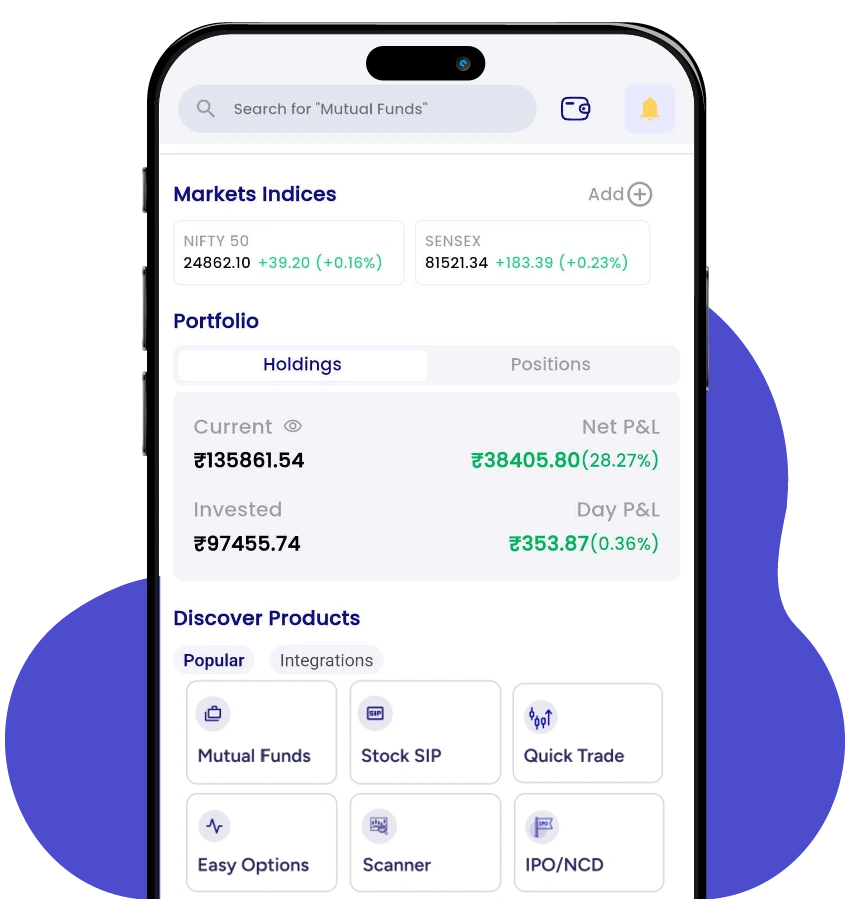What is Call Option and Put Option?
- 16th July 2025
- 7 min read
Are you missing out on gains in a rising market or unprotected during downturns? Understanding call and put options can help. For instance, a call option lets you buy stocks at a set price, expecting them to rise.
A put option enables you to sell at a higher price, even if the market falls. In FY25, retail investors made up 35.7% of premium turnover in index options. Read on to explore how these options work and how they benefit you.
What is a Call Option and How Does it Work?
To understand the call and put option better, you must have a clear idea of a call option, which gives you the right, without any obligation, to purchase an underlying asset at a target or strike price at a set date.
The concept here is to expect the price of an underlying asset to rise above your strike price, allowing you to exercise the call option at a lower cost and profit from the price difference. Thus, it allows you a profit from the price difference.
For example, suppose a stock is currently trading at INR 200. You buy a call option with a strike price of INR 210 and pay a premium of INR 8. If the stock price rises to INR 225 before expiry, your profit will be INR 7 per share: INR 225 (market price) – INR 210 (strike price) – INR 8 (premium).
What is a Put Option and How Does it Work?
Going for a put option during investments is a strategy to deal with a bearish market, as it allows you to sell an underlying asset at a predetermined (strike) price even when the market is down. This helps protect against potential losses from price drops in a volatile market.
Suppose the current price of a stock is INR 300, and you buy a put option with a strike price of INR 290, paying a premium of INR 10. If the asset’s price drops to INR 270, you can still sell it at INR 290 and make a net profit of INR 10 (INR 20 drop – INR 10 premium).
With PL Capital Group – Prabhudas Lilladher, you can also trade in derivatives and trade using call and put options. Download the PL Capital app today!
Basic Terminologies for Call And Put Options
Now that you have an idea about what is call option and a put option are, let us understand some basic terms regarding them:
-
Target or Strike Price
This is the price you set to buy or sell an underlying asset at a future time to gain from the market or to evade losses when the market or the stock is less profitable.
-
Spot Price
A spot price is the price of the stock or any other underlying asset at which it is trading currently. From the example of the put option above, the current value of the stock, i.e INR 300, is a spot price.
-
Option Premium
When you buy an option from the option seller, you must pay a premium, known as the option premium.
-
Option Expiry
It is the expiry date of the option contract, which is usually the last Thursday of the month. For example, if you buy an option on the 1st of July 2025, its expiry date should be the 31st of July 2025.
Process To Calculate Call and Put Option Payoffs
Below is a detailed breakdown of how to calculate the payoffs from trading call and put options:
| Paremeters | For Buyers | For Sellers |
| Payoff calculation for call options | Here, as a buyer, you only gain when the price of your purchased asset exceeds your target price. | Sellers will face potential losses if they sell a call when there is a rise in the market price. |
| You can use this formula to get Payoff = [(Market Price – Target Price) – paid premium] | The formula here is Payoff = [Received Premium- (Market Price – Target Price)] | |
| Payoff calculation for a put option | You can profit even when the market value of an underlying asset falls with a put option. | Selling put options means you are agreeing to buy stocks even when the market price falls more than your set target price, resulting in losses. |
| You can use this formula of Payoff = [(Target Price – Market Price) – Paid Premium] | Here is a formula for this payoff = [Received Premium -(Strike Price – Market Price)] |
Difference Between Call and Put Option
Below are the detailed differences between the call option and the put option to stay informed:
| Parameters | Call Option | Put Option |
| Gains | Here, gains are unlimited. | Here, gains are limited to the target price. |
| Losses | The loss is limited to the amount you paid as a premium. | Potential loss is limited to your target price minus the amount paid for the premium. |
| Sentiment of the market | Best suited for a bullish market. | Best suited for a bearish market. |
Risks and Rewards in Call and Put Options
You must be aware of some rewards and risks related to put and call options:
| Parameters | Call Sellers | Call Buyers | Put Sellers | Put Buyers |
| Maximum gain or profit | Limited to the premium received. | Potentially unlimited profit if the stock price rises significantly. | Limited to the premium received. | Limited to the difference between the strike price and the market price minus the premium. |
| Maximum losses | Unlimited if the stock price rises sharply. | Limited to the premium paid, even if the option is not exercised. | High losses if the stock price falls significantly below the strike price. | Limited to the premium paid. |
| Zero loss and profit | Occurs when spot price = strike price + premium received. | Occurs when spot price = strike price + premium paid. | Occurs when spot price = strike price – premium received. | Occurs when spot price = strike price – premium paid. |
Conclusion
As an investor, learning about call and put options is important, as you can maximise your returns when the market is going up or protect your investments against losses. These options allow you to buy or sell underlying assets at a predetermined date and price.
With PL, you can also optimise your potential return on investments by investing in derivatives, stocks, mutual funds and more. Download the PL app today!
FAQ’s
1. What factors influence option prices?
There are several factors which influence the option pricing. These include the strike price, underlying asset price, interest rate, dividends, expiry date, etc.
2. What are put and call options with an example?
You can buy a call option at INR 150 and expect the price of the stock to go up. Suppose the stock price is now INR 170, you gain a profit using a call option. Similarly, you can buy a put option at INR 90 and sell that stock at the same price, even if the price is now INR 70.
3. Does the Out-of-The-Money option have an intrinsic value?
No, Out-of-The-Money or OTM options do not have an intrinsic value. However, they have an extrinsic or time value.
4. What is riskier: a call or a put?
For buyers of call and put options risk is limited or equal in both cases. For sellers, selling call options is riskier than selling put options.





